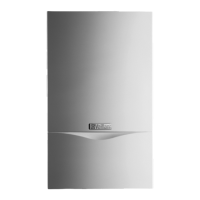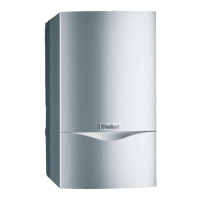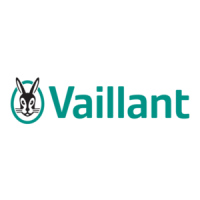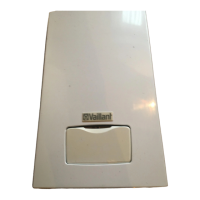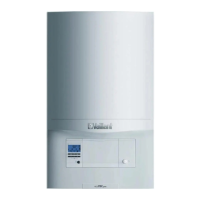Do you have a question about the Vaillant ecoMAX pro 18E and is the answer not in the manual?
Provides an overview of the Vaillant boiler and its performance.
Specifies the gas type the boiler is designed for and conversion options.
Highlights legal requirements for gas appliance installation.
Confirms the boiler's safety and performance testing.
Details compliance with EU directives for gas appliances and electrical safety.
Provides information on potential health hazards from appliance materials.
Advises on handling insulation pads to prevent skin, eye, or respiratory irritation.
Stipulates the use of only original Vaillant spare parts.
Offers advice on safe lifting and handling of the appliance.
Provides critical safety warnings for gas leaks, faults, and clearances.
Advises caution when handling sharp metal components.
Specifies minimum clearances required around the boiler for operation and servicing.
Explains the boiler's frost protection and system draining procedures.
Provides guidance on installing boilers in enclosed spaces.
Warns against removing or adjusting the boiler casing.
Instructs not to modify or block the condensate drain.
Explains the normal water vapour plume from condensing boilers.
Provides instructions for cleaning the boiler casing.
Recommends regular checks and servicing by a competent person.
Details the terms and conditions of the Vaillant warranty.
Caution on filling and pressurizing sealed systems by a competent person.
Checks required for all systems before operating the boiler.
Explains how to use the boiler's controls and displays for operation.
Advises on turning the boiler off, preferably via system controls.
Advises caution when handling sharp metal components.
Lists regulations and standards for boiler installation in GB and IE.
Details requirements for gas supply installation and testing.
Provides dimensions, data labels, and efficiency ratings of the boiler.
Presents detailed technical specifications for ecoMAX pro 18 E and 28 E models.
Covers earthing requirements, wiring standards, and isolation for the boiler.
Details the requirements for fitting a plastic drain pipe for condensate discharge.
Recommends programmer and room thermostat control, with TRVs.
Specifies suitable locations and restrictions for boiler installation.
Details minimum operational and servicing clearances required around the boiler.
Provides guidance for installing boilers in timber frame buildings.
States that permanent air vents are not required for room-sealed boilers.
Confirms that cupboard or compartment ventilation is not necessary.
Requires draining taps at low points for system and hot water drainage.
Notes that a safety valve is not required for open-vented systems.
Specifies pump fitting, isolating valves, and setting for temperature difference.
Requires a system bypass fitted at least 1.5 metres away from the boiler.
Emphasizes system flushing and use of suitable inhibitors for corrosion protection.
Describes requirements for feed and expansion cisterns and cold feed.
Warns that single feed indirect cylinders are unsuitable.
Covers regulations for unvented DHW systems and compatibility issues.
Lists compliance requirements for sealed water systems.
Details safety valve requirements for sealed systems, including discharge pipe routing.
Explains diaphragm type expansion vessels and calculation of volume.
Specifies requirements for a permanently fitted pressure gauge.
States that single feed indirect cylinders are unsuitable.
Describes provision for replacing water loss using a make-up bottle or filling loop.
Details methods for filling a sealed system at low level.
Lists various flue systems and accessories available for the boiler.
Provides details on positioning and clearances for flue terminals.
Describes how to install the flue from inside the building.
Instructions for safely unpacking the boiler unit.
Refers to flue system installation instructions for rear flue exit details.
Details flue installation for vertical, side, and bend configurations.
Guides on installing the wall mounting bracket for the boiler.
Explains how to position and secure the boiler onto the hanging bracket.
Covers gas supply connection, inspection, and purging requirements.
Details provision for water connections using 22mm compression couplers.
Specifies requirements for condensate drain pipe installation and discharge.
Explains access to the boiler terminal box and connecting controls.
Outlines preliminary electrical checks before connecting the boiler.
Steps before commissioning, including flushing and checking external controls.
Procedures for filling, venting, and checking sealed systems.
Details isolating the boiler, purging the gas supply, and checking pressure.
Step-by-step guide for the automated boiler lighting procedure.
Checks for gas inlet pressure and maximum gas rate.
Procedure for testing the heating system, including radiator balancing and draining.
Explains the use of mains/reset switch and user display functions.
Describes the boiler's display of operating temperature.
Details the automatic pump exercise to prevent sticking.
Instructs on demonstrating operation, advising on maintenance, and leaving literature.
Guide for converting the boiler from Natural Gas to LPG.
Recommends regular servicing for safe and efficient operation.
Outlines initial inspection tasks for heating and water systems.
Details checking burner operation, flame, and signs of damage.
Instructions for inspecting, cleaning, and checking the spark electrode.
Details servicing the burner, including gasket replacement and cleaning.
Guides for cleaning debris from the combustion chamber and heat exchanger.
Procedure for flushing and cleaning the condensate trap.
Instructions for checking and replacing the inner casing panel seal.
Guidance on checking expansion vessel charge pressure every three years.
Explains how to access status mode screens for boiler information.
Details how to display and cancel the five most recent faults.
Lists fault codes and their corresponding descriptions and comments.
Provides an overview of the Vaillant boiler and its performance.
Specifies the gas type the boiler is designed for and conversion options.
Highlights legal requirements for gas appliance installation.
Confirms the boiler's safety and performance testing.
Details compliance with EU directives for gas appliances and electrical safety.
Provides information on potential health hazards from appliance materials.
Advises on handling insulation pads to prevent skin, eye, or respiratory irritation.
Stipulates the use of only original Vaillant spare parts.
Offers advice on safe lifting and handling of the appliance.
Provides critical safety warnings for gas leaks, faults, and clearances.
Advises caution when handling sharp metal components.
Specifies minimum clearances required around the boiler for operation and servicing.
Explains the boiler's frost protection and system draining procedures.
Provides guidance on installing boilers in enclosed spaces.
Warns against removing or adjusting the boiler casing.
Instructs not to modify or block the condensate drain.
Explains the normal water vapour plume from condensing boilers.
Provides instructions for cleaning the boiler casing.
Recommends regular checks and servicing by a competent person.
Details the terms and conditions of the Vaillant warranty.
Caution on filling and pressurizing sealed systems by a competent person.
Checks required for all systems before operating the boiler.
Explains how to use the boiler's controls and displays for operation.
Advises on turning the boiler off, preferably via system controls.
Advises caution when handling sharp metal components.
Lists regulations and standards for boiler installation in GB and IE.
Details requirements for gas supply installation and testing.
Provides dimensions, data labels, and efficiency ratings of the boiler.
Presents detailed technical specifications for ecoMAX pro 18 E and 28 E models.
Covers earthing requirements, wiring standards, and isolation for the boiler.
Details the requirements for fitting a plastic drain pipe for condensate discharge.
Recommends programmer and room thermostat control, with TRVs.
Specifies suitable locations and restrictions for boiler installation.
Details minimum operational and servicing clearances required around the boiler.
Provides guidance for installing boilers in timber frame buildings.
States that permanent air vents are not required for room-sealed boilers.
Confirms that cupboard or compartment ventilation is not necessary.
Requires draining taps at low points for system and hot water drainage.
Notes that a safety valve is not required for open-vented systems.
Specifies pump fitting, isolating valves, and setting for temperature difference.
Requires a system bypass fitted at least 1.5 metres away from the boiler.
Emphasizes system flushing and use of suitable inhibitors for corrosion protection.
Describes requirements for feed and expansion cisterns and cold feed.
Warns that single feed indirect cylinders are unsuitable.
Covers regulations for unvented DHW systems and compatibility issues.
Lists compliance requirements for sealed water systems.
Details safety valve requirements for sealed systems, including discharge pipe routing.
Explains diaphragm type expansion vessels and calculation of volume.
Specifies requirements for a permanently fitted pressure gauge.
States that single feed indirect cylinders are unsuitable.
Describes provision for replacing water loss using a make-up bottle or filling loop.
Details methods for filling a sealed system at low level.
Lists various flue systems and accessories available for the boiler.
Provides details on positioning and clearances for flue terminals.
Describes how to install the flue from inside the building.
Instructions for safely unpacking the boiler unit.
Refers to flue system installation instructions for rear flue exit details.
Details flue installation for vertical, side, and bend configurations.
Guides on installing the wall mounting bracket for the boiler.
Explains how to position and secure the boiler onto the hanging bracket.
Covers gas supply connection, inspection, and purging requirements.
Details provision for water connections using 22mm compression couplers.
Specifies requirements for condensate drain pipe installation and discharge.
Explains access to the boiler terminal box and connecting controls.
Outlines preliminary electrical checks before connecting the boiler.
Steps before commissioning, including flushing and checking external controls.
Procedures for filling, venting, and checking sealed systems.
Details isolating the boiler, purging the gas supply, and checking pressure.
Step-by-step guide for the automated boiler lighting procedure.
Checks for gas inlet pressure and maximum gas rate.
Procedure for testing the heating system, including radiator balancing and draining.
Explains the use of mains/reset switch and user display functions.
Describes the boiler's display of operating temperature.
Details the automatic pump exercise to prevent sticking.
Instructs on demonstrating operation, advising on maintenance, and leaving literature.
Guide for converting the boiler from Natural Gas to LPG.
Recommends regular servicing for safe and efficient operation.
Outlines initial inspection tasks for heating and water systems.
Details checking burner operation, flame, and signs of damage.
Instructions for inspecting, cleaning, and checking the spark electrode.
Details servicing the burner, including gasket replacement and cleaning.
Guides for cleaning debris from the combustion chamber and heat exchanger.
Procedure for flushing and cleaning the condensate trap.
Instructions for checking and replacing the inner casing panel seal.
Guidance on checking expansion vessel charge pressure every three years.
Explains how to access status mode screens for boiler information.
Details how to display and cancel the five most recent faults.
Lists fault codes and their corresponding descriptions and comments.
